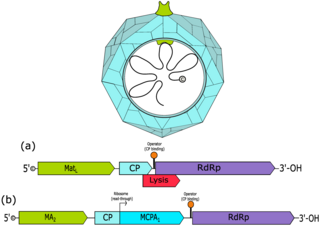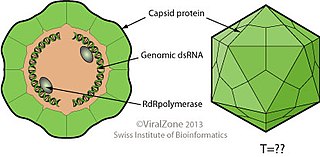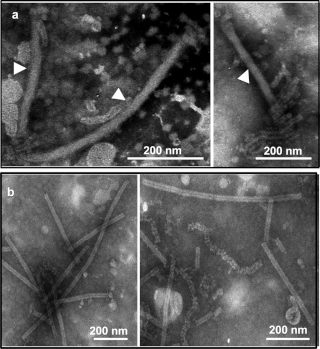Virus classification is the process of naming viruses and placing them into a taxonomic system similar to the classification systems used for cellular organisms.

Totiviridae is a family of double-stranded RNA viruses. Giardia lamblia, leishmania, trichomonas vaginalis, and fungi serve as natural hosts. The name of the group derives from Latin toti which means undivided or whole. There are 28 species in this family, assigned to 5 genera.

Fiersviridae is a family of positive-strand RNA viruses which infect prokaryotes. Bacteria serve as the natural host. They are small viruses with linear, positive-sense, single-stranded RNA genomes that encode four proteins. All phages of this family require bacterial pili to attach to and infect cells. The family has 185 genera, most discovered by metagenomics. In 2020, the family was renamed from Leviviridae to its current name.

Chrysoviridae is a family of double-stranded RNA viruses. Members of the family are called chrysoviruses.

Baltimore classification is a system used to classify viruses based on their manner of messenger RNA (mRNA) synthesis. By organizing viruses based on their manner of mRNA production, it is possible to study viruses that behave similarly as a distinct group. Seven Baltimore groups are described that take into consideration whether the viral genome is made of deoxyribonucleic acid (DNA) or ribonucleic acid (RNA), whether the genome is single- or double-stranded, and whether the sense of a single-stranded RNA genome is positive or negative.

Totivirus is a genus of double-stranded RNA viruses in the family Totiviridae. Fungi serve as natural hosts. The name of the group derives from Latin toti which means undivided or whole. There are seven species in this genus.

Alphachrysovirus is a genus of double-stranded RNA viruses. It is one of two genera in the family Chrysoviridae. They infect fungi, in particular Penicillium. Their name is derived from the Greek word chrysos which means yellow-green. There are 20 species in this genus.

Marnaviridae is a family of positive-stranded RNA viruses in the order Picornavirales. The first species of this family that was isolated is Heterosigma akashiwo RNA virus (HaRNAV) in the genus Marnavirus, that infects the toxic bloom-forming Raphidophyte alga, Heterosigma akashiwo. Using a sequence-based framework an additional twenty marine RNA viruses have been added to the family.

Picornavirales is an order of viruses with vertebrate, invertebrate, protist and plant hosts. The name has a dual etymology. First, picorna- is an acronym for poliovirus, insensitivity to ether, coxsackievirus, orphan virus, rhinovirus, and ribonucleic acid. Secondly, pico-, meaning extremely small, combines with RNA to describe these very small RNA viruses. The order comprises viruses that historically are referred to as picorna-like viruses.

Alphaflexiviridae is a family of viruses in the order Tymovirales. Plants and fungi serve as natural hosts. There are 65 species in this family, assigned to six genera. Diseases associated with this family include: mosaic and ringspot symptoms.
Gammaflexiviridae is a family of viruses in the order Tymovirales. Fungi serve as natural hosts. There is only one genus in the family, Mycoflexivirus, which has one species: Botrytis virus F.

Megabirnaviridae is a family of double-stranded RNA viruses with one genus Megabirnavirus which infects fungi. The group name derives from member's bipartite dsRNA genome and mega that is greater genome size than families Birnaviridae and Picobirnaviridae. There is only one species in this family: Rosellinia necatrix megabirnavirus 1. Diseases associated with this family include: reduced host virulence.

Quadriviridae is a family of double-stranded RNA viruses with a single genus Quadrivirus. The fungi Rosellinia necatrix serves as a natural host. The name of the group derives from the quadripartite genome of its members where in Latin quad means four. There is only one species in this family: Rosellinia necatrix quadrivirus 1.

Dinovernavirus is a genus of double-stranded RNA viruses in the family Reoviridae and subfamily Spinareovirinae. Member viruses replicate in a variety of mosquito cell lines. The name is an abbreviation for double-stranded, insect, novem, rna virus. There is one species in the genus: Aedes pseudoscutellaris reovirus.

Mymonaviridae is a family of negative-strand RNA viruses in the order Mononegavirales, which infect fungi. Fungi serve as natural hosts. The name is a portmanteau of Ancient Greek myco, which means fungus, and mononegavirales. This family was established to accommodate Sclerotinia sclerotiorum negative-stranded RNA virus 1 (SsNSRV-1) a novel virus discovered in a hypovirulent strain of Sclerotinia sclerotiorum.
In virology, realm is the highest taxonomic rank established for viruses by the International Committee on Taxonomy of Viruses (ICTV), which oversees virus taxonomy. Six virus realms are recognized and united by specific highly conserved traits:
Duplornaviricota is a phylum of RNA viruses, which contains all double-stranded RNA viruses, except for those in phylum Pisuviricota. Characteristic of the group is a viral capsid composed of 60 homo- or heterodimers of capsid protein on a pseudo-T=2 lattice. Duplornaviruses infect both prokaryotes and eukaryotes. The name of the group derives from Italian duplo which means double, rna for the type of virus, and -viricota which is the suffix for a virus phylum.

Ghabrivirales is an order of double-stranded RNA viruses. It is the only order in the class Chrysmotiviricetes. The name of the class is a portmanteau of member families: chrysoviridae, megabirnaviridae, and totiviridae; and -viricetes which is the suffix for a virus class. The name of the order derives from Said Ghabrial, a pioneering researcher who studied viruses in this order, and -virales which is the suffix for a virus order.

Sobelivirales is an order of RNA viruses which infect eukaryotes. Member viruses have a positive-sense single-stranded RNA genome. The name of the group is a portmanteau of member orders "sobemovirus-like" and -virales which is the suffix for a virus order.
Naldaviricetes is a class of viruses, which infect arthropods. Members of Naldaviricetes are characterized by large enveloped rod-shaped virions, circular double-stranded DNA genomes, and replication in the nucleus of the host cell. All of them share a set of unique genes not found in other viruses, which include the presence of multiple interspersed direct repeats, various subunits of DNA polymerase and RNA polymerase, four late expression factor genes, and infectivity factor genes suggesting a common host entry mechanism.













